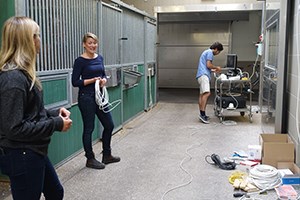With the help of the latest advancements in objective movement analysis systems and new methods in identifying pain behaviours, we wish to better understand the connection between irregular movement patterns and pain.
Orthopedic pain contributes to suffering and decreased welfare in large animals. Lameness in large animals is considered to be the major clinical sign of orthopedic disorders. Until recently, the identification of orthopedic disorders, with related orthopedic pain, has relied entirely on the recognition and quantification of lameness by a subjective visual evaluation of motion symmetry, reflecting the degree of pain only partially. Attempts to integrate a more accurate pain assessment into the lameness scales have never been done.
With funding from FORMAS, we are combining the latest in new technologies for objective motion analysis with new methods to carefully identify pain behaviors to better recognize animals suffering from orthopedic pain as well as better understand the connection between an irregular movement pattern and pain.
For the first time, we will develop camera and sensor based symmetry scores for asymmetry of walking horses and cows. We will use these scores to objectively classify lame horses and cows, in which we also assess their behavioral signs of pain as measured by modern composite pains scores, automated evaluation of facial expressions of pain and analgesic testing if appropriate.
On the basis of our results, we will create internet-based training programs that teach animal professionals and owners how to identify lameness and pain in horses and cattle without the use of technology.
This project may also open the way for the development of modern camera based symmetry measurements for automated and individual recognition of clinical painful lameness in large herds.
Marie Rhodin and Pia Haubro Andersen are spearheading a unique group of highly experienced researchers in movement analysis, pain evaluation, statistics and clinical orthopedic research in horses and cattle. Katrina Ask is their doctoral candidate. Together, we wish to answer one of the most important welfare questions of all: does it hurt?
